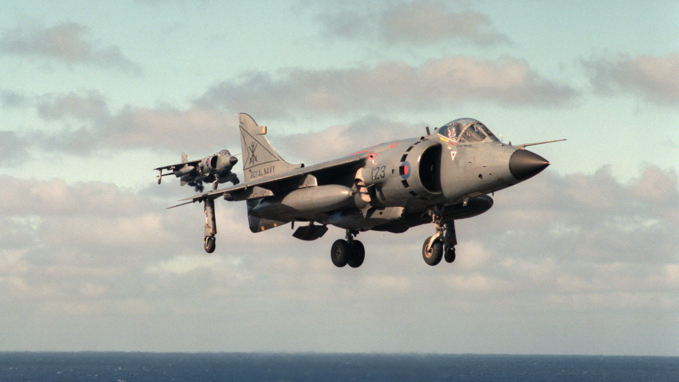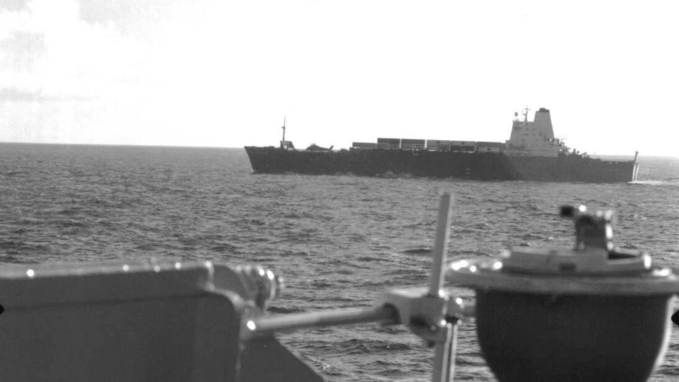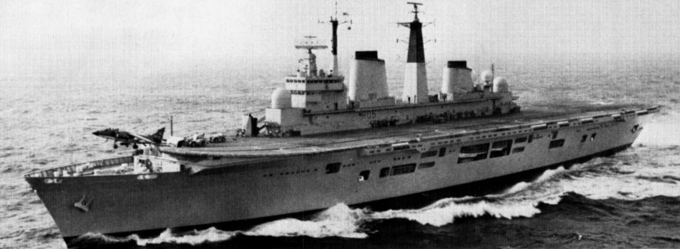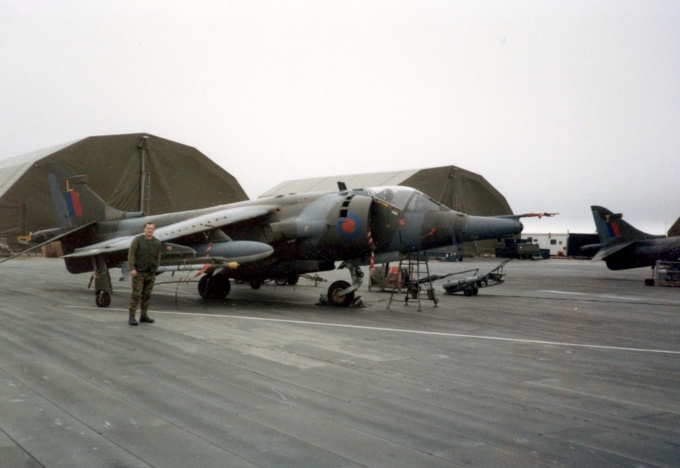The Harrier GR.3's most noteworthy deployment was to the Falkland Islands during, and after, the 1982 Falklands War. When the war began on 2nd April 1982 with the Argentine invasion of the Falkland Islands, Britain was forced to rapidly assemble a task force to retake the islands, located some 8,000 miles away from the British mainland. The decommissioning of the aircraft carrier HMS Hermes was cancelled and, along with HMS Invincible (itself in the process of being sold to Australia), it was rapidly prepared for deployment. The two aircraft carriers left Portsmouth Naval Base three days later (on 5th April), setting sail to Ascension Island (a small British island in the South Atlantic); which was the designated rendezvous point from where the task force would then sail to the Falklands. The two carriers were carrying Sea King helicopters and Sea Harrier FRS.1 fighters (12 Sea Harriers on Hermes and 8 on Invincible).
It was thought that the Sea Harriers would have a very high attrition rate (with all of them expected to be lost within the first few days of the war) and so reinforcements would be needed. With the task force having left Ascension Island on 18th April, and now en route to the Falklands, getting the additional aircraft to it would be a major logistical challenge. In need of transport, the British Government requisitioned the Atlantic Conveyor, a civilian container ship, and rapidly modified it to carry aircraft. The Atlantic Conveyor set sail for Ascension Island on 25th April, carrying six Wessex and five Chinook helicopters. Meanwhile, eight additional Sea Harriers were obtained from a training squadron, and ten RAF Harrier GR.3s were re-assigned from their squadron to the task force. The additional aircraft would be flown to Ascension Island in order to join the Atlantic Conveyor and be transported the rest of the way to the Falklands.
Over 30th April–2nd May, the eight Sea Harriers completed the >4,000-mile flight to Ascension Island (via Banjul, Gambia). They were followed by the ten GR.3s, which flew directly to Ascension Island through 3rd May–6th May; nine of the GR.3s completed the journey, with one turning back due to engine trouble. Once at Ascension Island the Harriers were serviced and loaded onto the Atlantic Conveyor; the Harrier’s VTOL capabilities were put to good use with each one taking off from the island’s air base, flying to the Atlantic Conveyor, and landing vertically on the ship’s deck. All the Sea Harriers and six of the GR.3s were loaded onto the Atlantic Conveyor, with three of the GR.3s being left behind to provide air defence for RAF Wideawake (the British base on Ascension Island).
Having been originally designed for use purely as ground-attack aircraft, the Harrier GR.3s on the Atlantic Conveyor and stationed at Wideawake were hastily modified to allow them to partake in air-to-air combat; support was added for AIM-9G/AIM-9L Sidewinders and AN/ALE-40 flare dispensers were added in the underside of the rear fuselage. The Atlantic Conveyor set sail for the Falkland Islands, arriving in the area on 18th May.
Arrival in the Falklands
Once the Atlantic Conveyor had reached the task force, the Harriers were prepared for flight. Over the next two days, the Sea Harriers and Harrier GR.3s took off vertically from the ship’s deck and flew to their assigned aircraft carriers; the Sea Harriers were split between the two carriers (with four going to Hermes, and four to Invincible), while all six of the GR.3s were sent to Hermes. By the end of 20th May, all Harriers had safely arrived at their assigned carriers.
The Atlantic Conveyor stayed with the task force, still carrying its helicopters and other supplies. On the 25th May, the Atlantic Conveyor unloaded its first Chinook helicopter (the now-famous “Bravo November”) and shortly afterwards was hit by two Exocet missiles, killing twelve crew members and causing an uncontrollable fire. The Atlantic Conveyor was abandoned and sank a few days later with the loss of all remaining helicopters and supplies onboard.
Once in the Falklands, the Harrier GR.3s primarily focused on ground attack missions. It was originally expected that they would be forced to take over the fleet air defence role when the Sea Harriers were lost, however the Sea Harrier proved remarkably effective, with only six being lost during the conflict (all due to accidents or ground fire). Not being designed for naval use, the Harrier GR.3's Inertial Navigation and Attack System (INAS) proved unusable during ship-borne operations, due to an inability for it to be properly calibrated while on a moving platform.
On 21st May, British forces carried out an amphibious landing at Port San Carlos (located on the west coast of East Falkland), and by 2nd June they had managed to construct a temporary airstrip. Although the runway was only 260 m long, it was enough for the VTOL-capable Harriers and Sea Harriers to operate on. As well as allowing the Harriers to operate from a location closer to the battle, operating from Port San Carlos allowed the GR.3s to make full advantage of their advanced INAS systems for ground attack missions.
Additional Harrier GR.3s deployed
With the Harriers performing well in the Falklands, the British worked to deploy additional GR.3s to the conflict. Over 24th–26th May, three RAF Phantom FGR.2s were deployed to Ascension Island to take over air defence duties from the three Harrier GR.3s stationed there. Then over 29th May–2nd of June, six additional GR.3s were flown the >4,000-mile journey from the UK to Ascension Island, bringing the total number of GR.3s on the island to nine.
On 1st June, two GR.3s flew the 3,800-mile trip from Ascension Island to HMS Hermes, landing after nearly eight and a half hours of continuous flight. This process was repeated on 8th June, bringing the total number of GR.3s in the Falklands to ten. These four Harriers were unique in that they had their starboard (right-hand side) ADEN gun pod replaced with the “Blue Eric” electronic countermeasure pod to provide self-defence against enemy radars. The pod was developed incredibly quickly, going from initial concept to first prototype in seven days, and having ten examples produced and ready for combat in fifteen days (from initial concept).
The Blue Eric pod was essentially a simplified Marconi “Sky Shadow” ECM pod fitted into the shell of a Harrier ADEN gun pod.
After this, the four remaining serviceable GR.3s on Ascension Island were flown to the Contender Bezant (another requisitioned civilian cargo ship); they landed vertically on the ship’s deck and were transported to the island in the same manner as those on the Atlantic Conveyor. They arrived at the Falklands on 10th June, however they were not unloaded until 7th July, after the war had ended (on 14th June).
End of the war and No. 1453 Flight RAF
Argentina surrendered on 14th June 1982, bringing an end to the Falklands War after 74 days of fighting. The Harriers performed far better than originally expected in the Falklands; the 28 Sea Harrier FRS.1s completed 1,435 sorties, achieving 20 confirmed (and 3 probable) kills against Argentine aircraft, with only 6 losses. The 10 Harrier GR.3s which saw combat completed 126 sorties with 4 losses. All Harrier/Sea Harrier losses in the conflict were due to ground fire or accidents, with no losses in air-to-air combat.
Following the end of the war, there was a need to defend the islands against any possible future attack. The long term plan was to deploy Phantom FGR.2s to defend the islands; however the runway at Port Stanley Airport (the main airport on the islands) had been damaged from multiple British attacks while it was in use by Argentine forces, and was also too short to allow for Phantom operations. After the conflict ended the RAF took control of Port Stanley Airport, renaming it to RAF Stanley. They began the process of clearing unexploded mines/ordnance, repairing the runway, and converting it into a temporary RAF base. With the runway repair and extension set to take several months, the Harrier GR.3s were once again called upon for air defence duties. A detachment of six GR.3s were stationed at RAF Stanley on 4th July 1982. Each armed with two AIM-9L Sidewinders, these Harriers became No. 1453 Flight RAF and were responsible for defending the islands from air attack.
The runway repairs and extension were completed on 27th August 1982, and over 18th–22nd October 1982, six Phantom FGR.2s arrived on the Falkland Islands (having previously flown to Ascension Island). With the Phantoms taking over as the main air defence of the Falklands, the role of the Harrier GR.3s shifted to providing back-up air defence when needed, as well as being prepared for a ground attack role in the event of another invasion. The No. 1453 Flight Harriers remained stationed at RAF Stanley until the RAF’s new purpose-built base RAF Mount Pleasant opened in 1985.
Bibliography
- A Close Run Thing — The Harrier Deployments to the South Atlantic. | Victor XM175
- F4s — and more Harrier GR3s Head South. | Victor XM175
- Falklands Campaign: Electronic Warfare Story Revealed. (1984). Aircraft Engineering and Aerospace Technology, Vol. 56 No. 12.
- First Report on Farnborough. (1980). Aircraft Engineering and Aerospace Technology, Vol. 52 No. 8.
- The British Aerospace Harrier Case Study in Aircraft Design. American Institute of Aeronautics & Astronautics.
- First-Generation Harriers / Sea Harrier. | AirVectors
- Falklands War Harriers and Sea Hrriers. | Harrier Special Interest Group
- BAe Harrier GR.3. | Imperial War Museum
- Air War in the Falklands. | Air & Space Magazine
- Hawker Siddeley Harrier GR3. | Royal Air Force Museum
- The Amazing Tale Of Bravo November, The British Chinook Helicopter That Refused To Die. | The Drive
- The San Carlos Forward Operating Base. | ThinkDefence
- Post Conflict and RAF Stanley. | ThinkDefence






